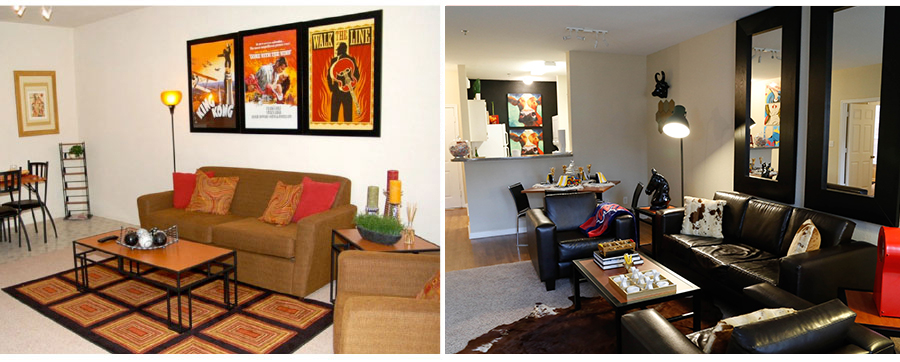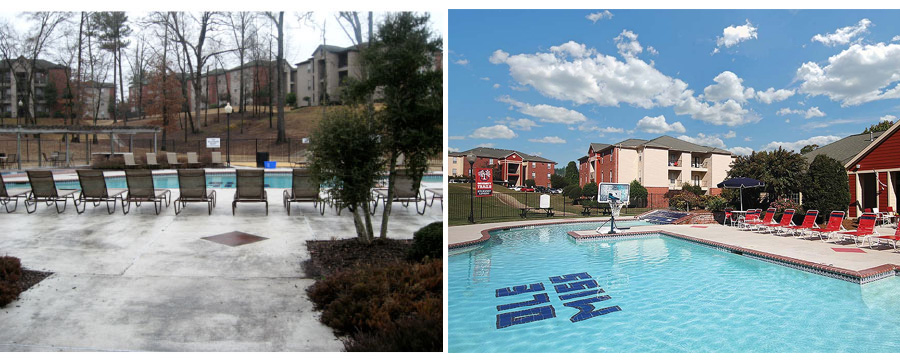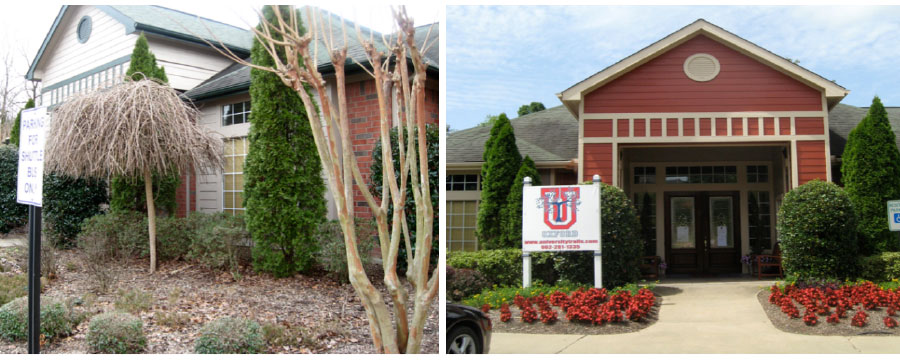Case Studies
Website: www.utrailsoxford.com
FKA Sterling (Dinerstein) – University Terrace
Date of Construction: 1999
Project Size: 156 units/492 beds
Close date: 4/30/10
Terms: Cash at Closing (subsequently refinanced)
Total Balance Sheet at closing: $7,300,000
Going-in cap rate based on T-12: 8.34%
Going-in cap rate based on T-6(2011): 12.37%
Occupancy at Closing: 85% (physical)
Pre-lease at time of closing: 27%
Occupancy at Fall 2011 Opening: 99% (physical)
Effective Yr-1 Rental Income Increase: 24%
Forecasted Cash-on-Cash Yr-1: 19.23%
In late 2009, TEXLA identified a distressed student housing asset in Oxford, MS. It was developed in 2001 as a Sterling University brand and at various times had been marketed by the original developer. For a variety of reasons, the project was never sold. Similar to other student housing markets, Oxford became over-built in the latter part of the decade. By the time of TEXLA’s purchase, rents had contracted substantially. However, the leverage on the property reflected the project’s original rent projections. The debt service simply wasn’t sustainable at depressed rental rates. After several capital infusions by the developer, it decided it was no longer willing to support the project financially.
Through a long-standing brokerage contact, TEXLA learned the asset was controlled by a special servicer, Centerline, and that gaining control of the asset would necessitate working with the special servicer and the original sponsor. In an attempt to engage Centerline, TEXLA made a blind offer on the property. After several weeks of correspondence, Centerline finally engaged. In January 2010, a letter of intent was executed for TEXLA’s purchase of the property.
In April 2010, the principals of Vermilion and TEXLA closed on the acquisition of the property. Because of its poor lease-up under previous management, debt financing from Freddie Mac and Fannie Mae was unavailable, and they closed the transaction with all cash.
With TEXLA’s purchase, the property’s basis was adjusted down to approximately 60-70% of the original value, a figure much more sustainable vis-a-vis the property’s cash flow.
In concert with the closing, TEXLA established a new bus service to the property. Previously, the bus service had passed the front of the property but did not actually stop/pick-up and drop-off students. TEXLA worked quickly to build a relationship with the Oxford University Transit office to have it approve bus service for the property, which was achieved on the first day of ownership.
This change had an immediate positive impact on the property’s bottom line of approximately $40,000 annually. It allowed for the elimination of cost associated with staffing, maintenance and insurance for the passenger van previously operated by the property. The bus now runs every 7 minutes and the property is the “first stop off and last stop before campus.”

The next major focus was the units themselves. TEXLA made a conscious decision on what type of product it wanted to sell and to associate with the University Trails brand. TEXLA believed that investing $500,000 in new furniture, carpet, paint and tile would draw students to the property. While the property was 27% pre-leased at the time of closing, its closest competition in terms of age, etc. was close to 80% and rising. About a month later, it hit 100%. TEXLA decided, based on analysis of supply/demand in the market, to raise rents (approximately 10%), and to deliver the new carpet, flooring, furniture, etc. for each unit. After the makeover of the model/show unit, the response was overwhelming. Leasing velocity showed noticeable improvements and by mid June, the property was approximately 58% pre-leased. To improve curb appeal, TEXLA painted an accent color on the club building, added flowers around the community building and improved the landscaping. TEXLA also purchased new and/or repaired all of the existing workout equipment, and added new pool furniture. TEXLA also launched a new University Trails website at the time of close which helped give the property an edge over the rest on the online market. Further, it also helped allow the property to track web traffic and follow up on all online inquiries.
Before After

Before After

Before After

Forty five days following closing, TEXLA met with a key Freddie representative and outlined what had transpired since closing, highlighting the property’s successful lease up. He asked that leasing reports be sent to him weekly. On July 19th, the property passed its historical mark in terms of leasing. At that point, Freddie Mac fully engaged.
The final hurdle was turnover. Leases expired on August 6, and move-in occurred on August 15. Over the course of the intervening 9 days, TEXLA turned 110 of the 154 units with complete carpet, paint, flooring and furniture. Only two residents couldn’t move in on commencement date, and TEXLA bought them dinner and a nice hotel for the night.
The loan closed in September 2010. The positive leasing continued, and ultimately, the property reached 99% physical occupancy. In order to close the loan, the property had to achieve a rental income of $136,558. September rental income was $162,873, exceeding the threshold by nearly 20%.
Update: A supplement loan totaling $11M was placed on the property in March 2014 allowing for the return of owner’s equity at near a 3 x multiple.
Website: www.campussqr.com
History
The former Johnson City Middle School was redeveloped into student housing in 2009. For a variety of reasons, the renovation was not successful, and the building went through bankruptcy proceedings from 2009 to 2011. When THP was engaged in April 2011, the property was approximately 20% leased with fewer than 5% of the units leased for Fall 2011. The property grossed less than $200,000 in income for 2010. As the asset emerged from bankruptcy, TEXLA was tasked with turning the property into a profitable asset.
First Steps
As a first step, THP rebranded the property. The former name, C Fred Plaza, simply didn’t provide any identity to the property. After considering several names, TEXLA decided on Campus Square. The property is located approximately 1.5 miles from Binghamton University which has approximately 15,000 students. The property is also situated near a teaching hospital, UHS Wilson Hospital, as well as 6,000+ student Broome County Community College (BCCC). THP quickly forged relationships with all 3 institutions to try to determine what demand, if any, there might be for Campus Square once the rebranding was completed. While focusing on all three, THP targeted one market segment particularly – BU’s Dual Diploma Program which had a relationship with a university in Turkey. THP learned that the building had had some history of occupancy with students in this program, and thus approached the program director, Oktay Sekercisoy, to foster the relationship. Mr. Sekercisoy advised that the single greatest obstacle his international student population faced was transportation. Because BU’s bus only runs intermittently near the project, TEXLA addressed this concern by purchasing a shuttle van.
Focus on Repositioning
Over the course of May and June, THP focused on a few specific areas. First, the units were converted from a joint-several lease structure to a by-the-bed program. With that program in place, the leases were restructured to include utilities, with a cap. Second, THP enhanced a very large common area formerly utilized as a library. Management installed flat panel TV’s, set up a computer lab and scattered sofas, tables and chairs through the first floor of this approximately 5,000 square foot space. Fitness equipment was relocated to a vibrant area on the second floor from a cold section of the basement. Third, THP refocused the tour on the model unit, underscoring the units’ potential. It also highlighted the indoor basketball court, one of the remnants of the building’s original use. Finally, management tightly managed the property’s Craigslist ad, as it was the best source for leads during the summer.
Pricing
From a pricing perspective, the market clearly had a niche that wasn’t being served. For 2-bedroom units, there were a couple of projects at the high end of the market and plenty of the moderate to low end; however, there were few properties in the middle. THP focused on this market void. As the summer progressed, inquiries became more prevalent; word of mouth began to spread.
Also, based on the guidance from the director of the Dual Diploma Program, THP purchased the aforementioned shuttle van for the property and wrapped it with the Campus Square logo.
Fall lease-up
With the new identity established, leasing velocity surged. By the fall, the property was 96% leased (without concessions). Gross potential rent for September was over $60,000. The robust cash flow enabled the commencement of the last large capital project, replacing heating for the common area of the building.

